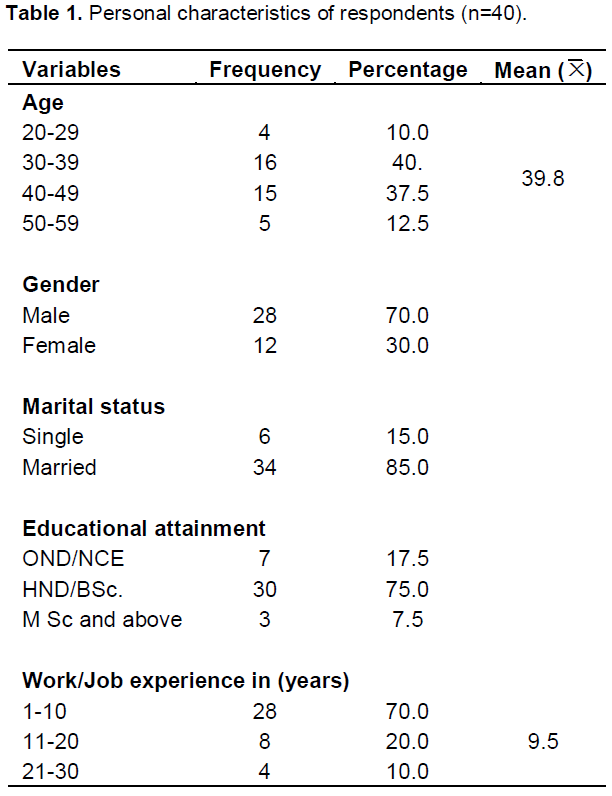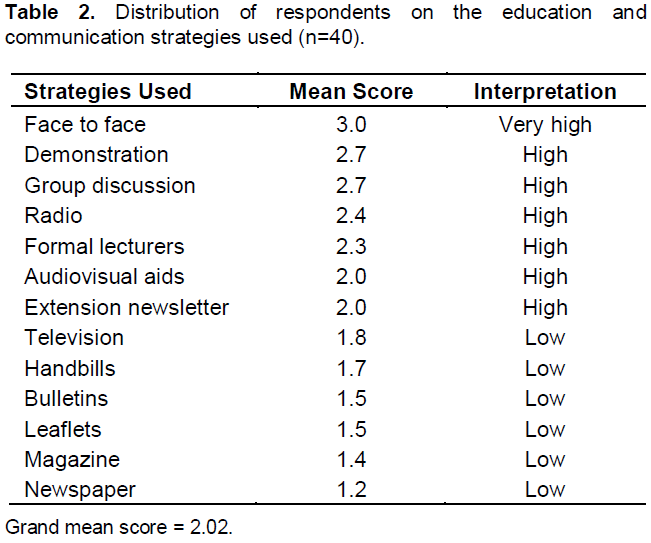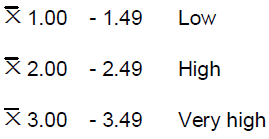ABSTRACT
The study examined the education and communication strategies used by extension workers in Onitsha Agricultural zone of Anambra State, Nigeria. A total of forty extension workers, comprising of thirty-five extension agents and five subject matter specialists were used. Structured questionnaires were used in collecting relevant information. Data were analyzed using frequency, percentage, mean and a Likert-type scale. The result revealed that Onitsha agricultural zone has young and highly educated extension personnel, which is an advantage for innovation adoption and transfer. The result showed that especially face to face, demonstration, group discussion, radio and formal lectures were effectively and efficiently used by the extension agents. The strategies had best performance in crops and livestock production by farmers. Majority (97.5%) of the respondents accepted incorporation of indigenous extension strategies such as meeting, town criers and group discussion because farmers learn easily through them and is used to them. It was concluded that incorporation of indigenous extension methods in the dissemination of information to farmers should be integrated into the extension delivery system in Anambra State.
Key words: Education, communication, indigenous, extension strategies.
Education and communication are inseparable in that one cannot occur in isolation of the other but it is of note that they differ widely. Communication is the medium through which education achieves its goals and is an indispensable partner in development. Education and communication are the two most important tools in extension service delivery in rural settings. Extension education according to Adereti and Ajayi (2005) is not solely concerned with teaching and securing the adoption of a particular improved practice but with changing the outlook of the farmer and encouraging his initiative in improving his farm and living standard. Van Den Ban and Hawking (1996) hold the view that extension education deals with strategies and questions associated withextension process. It collects and integrates where possible existing knowledge about this process from other scientific disciplines and adds to the knowledge through extension research. They posit that extension education is committed to the transformation of the result of research to the farmers and equally to transmit the problems of the farmers to the research institutes. Education is a process that helps to develop an individual morally, mentally, socially and technologically. This implies that education provides a guided systematic sequence of experience that facilitates learning and change. For farmers to adopt and successfully use improved farm techniques, they must understand the scientific complex knowledge and this requires effective teaching by agricultural extension agents.
Communication is the process by which an individual transmits stimuli to modify the behaviour of the other individuals. (Havland and Lee, 2005). Effective communication is seen as an essential tool for the establishment and maintenance of good social and working relationship and it enables people to exercise control over their environment (Braimoh, 1998; Anyanwu, 1992). Also effective communication is a pre-requisite to every aspect of group functioning.
Education and communication are used to displace errors which hold sway as official truth and to replace false, erroneous beliefs with newly verified theories and truth (Onu and Anyanwu, 1990). They went further to say that most of the great revolutions that had taken place in the scientific, socio-economic and political sphere of human history would have been impossible without education and communication especially on these primitive rural dwellers who still revel in the might of a fetish god or culture and abhor modernism.
Extension in rural areas via effective communication involves getting information from those who know to those who need to know in such a way that they understand, accept and most importantly act (Mortion and Mathewman, 2005). This implies that it is the duty of extension agents to develop methods or ways of communication that will result in positive action.
The strategies adopted by extension workers in the optimum utilization and effectiveness of their methods depend upon the structures of the society or community, the pattern of behaviour of individuals forming the society, religious sentiments, tradition and custom, mental consciousness of the people and the standard of literacy.
Educational content of agricultural development programmes in Nigeria seem to be drawn up without thorough research on local condition. This may be a major shortcoming of the ADP extension system in Nigeria and it has resulted in lack of interest among farmers. This study therefore sought to find out the education and communication strategies used by extension workers in increasing agricultural productivity in Onitsha agricultural zone of Anambra State. Specifically, the objectives of the study were to:
1) Describe the personal characteristics of extension workers in the zone.
2) Identify the education and communication strategies used by the extension workers.
3) Ascertain the local content of education and communication strategies currently in use by the Extension workers.
This study was carried out in Onitsha Agricultural Zone of Anambra State, Nigeria in the first quarter of 2008. The zone is made up of 5 Local Government Areas (L.G.As) - Onitsha North and South L.G.As, Idemili North and South L.G.As and Ogbaru L.G.A. The target population for the study was extension agents (EAs) and subject matter specialists (S.M.S). A multi-stage random sample technique was used in selecting respondents for the study from the existing ADP structure in the state-zone, block and circle; three LGAs- Onitsha South, Idemili North and Og,baru. From each LGA, 3 blocks were selected and from each block, 3 circles were randomly selected as well giving a total of 27 circles; from each, one EA was selected and one subject matter specialist (SMS) was randomly selected from each of the 3 LGAs. This gave a total of thirty (30) respondents used for the study.
Frequency counts, percentages, mean scores and a three-point Likert scale were involved in data analysis. The three-point Likert scale was weighted as follows: very high – 3, High – 2 and Low = 1. The following decision rule was used:
This means that any mean score below 2.00 was rated as not a relevant strategy.
Personal characteristics of respondents
Table 1 showed that majority (40.0%) of the respondents were within 30 to 39 years; 37.5% fell within the age range of 40 to 49 years; 12.5% were within 50 to 59 years and those within 20 to 29 years accounted for only 10.0%. The mean age was 39.8. This implies that the respondents were relatively young. Age is considered as an important variable because of its influence on people’s attitude, skill and aspiration (Obioha, 1995; Okolo, 2004). Because of their age, they could be highly responsive to education and communication strategies used in reaching farmers. This active age bracket will also favour variations in the use of strategies. The table also showed that majority (70.0%) were males while 30.0% were females. This is not surprising because field agricultural extension work in Nigeria had been dominated by male extension agents for the past years. This funding corroborates the work of Ogbanga (1998) that males were favoured more in extension activities than females.


Most (85.0%) of the respondents were married while those who were single constituted only (15.0%). Because majority of the respondents were married, it enhances efficient dissemination of innovation through education and communication strategies. Entries in Table 1 further revealed that majority (75.0%) had HND/BSc, 17.5% had the minimum educational qualification of ordinary National Diploma/National Certificate of Education (OND/NCE) and only 7.5% had higher degrees (M.Sc and above). This implies that the agricultural zone had highly educated and competent men and woman, potentially capable of disseminating new innovations to farmers and need to be encouraged to put more efforts in extension delivery. This is also an advantage for innovation adoption and transfer. This finding agree with the work of Madukwe et al. (2000) and Agwu (2000), high educational qualification helps in achieving the objectives of agro technology transfer programmes. Majority (70.0%) of the extension workers had 1 to 10 years experience; 20% had 11 to 20 years and 10.0% had 21 to 30 years experience on the job. This implies that these field workers have acquired enough relevant field experience and expected to use effectively the available education and communication strategies. Also, over the years, they have benefited immensely from the training and visit (T and V) extension delivery system (Onu et al., 2005).
Education and communication strategies used
Conduct of meetings
Table 3 revealed that majority (65%) of the respondents organized meetings for the farmers every fortnight as a strategy of education and communication of information towards enhancing agricultural productivity and skills on the local farmers. Also 30.0% organized meeting for farmers every three weeks while (5.0%) had their meeting on monthly basis. This implies that there were regular interaction with the farmers through meetings which seemed to be the most effective information dissemination and technology transfer strategy.
Effects of education and communication on some production variables
Table 4 showed the areas of best performance of strategies as perceived by the respondents. Mass media education and communication strategies on average for crop production (56%) and livestock (40%) were high while fishery (34%), forestry (22%) and processing (34.0%) were low. The implication of this result shows that mass media strategies used by the extension workers have helped farmers to perform well in crop and livestock production as well as income earning capacity. Also, a close scrutiny of the table revealed that radio performed better than all other variables considered. The above finding is in line with Chikwendu and Omenesa (1997) and Zubairu and Omenesa (1991) who reported that among all the tools of mass communication; radio emerged as the most effective. Also, Benneth (2003) and ADB (2003) observed that radio and television are powerful technologies for education and communication. This implies that the areas the farmers performed best were in crop and livestock production, applying the information technology received from extension workers.
Table 4 revealed that crop and livestock had the highest impact on the productive potentials and income of the rural farmers, even in small group discussions.
Levels of local content of education and communication strategies
Entries in Table 5 showed that majority (97.5%) accepted the incorporation of indigenous strategies in extension services while only 5% had the view that it should not be incorporated into the system. The implication of this result is that indigenous strategies when incorporated into extension services will help yield effective results and also more positive impact on the farmers’ income. On their reasons for accepting indigenous strategies, majority (52.5%) were of the opinion that they learn easily with them while 47.5% said that they are used to them. This implies the opinion that they learn easily with them while 47.5% said that they are used to them. This implies that it will yield good result on the farmers when applied in their agricultural training for production and income earning strategies.
Indigenous education and communication strategies
Information on personal characteristics indicated that extension division of Onitsha Agricultural Zone of Anambra State was dominated by young, married and highly educated workers, capable of effectively communicating with their clientele in the extension system and many of them had acquired enough relevant experience on the job.
The various education and communication strategies used showed that they contributed efficiently and effectively in achieving success in disseminated information and practices and had impact on the farmers especially on crop and livestock production and income earning capacities. The indigenous education and communication strategies incorporated into extension services yielded positive results on the income earning capabilities of farmers. In the light of the major findings of this study, the following recommendations were advanced. The state government should maintain high incentives on extension workers to enable them put more efforts in extension services delivery.
Efforts in the use of education and communication strategies especially, face to face, radio, discussion groups and demonstration should be intensified by extension workers since this aid in increasing the income of the farmers, thus the possibility of better living standards. Finally, extension workers should incorporate indigenous education and communication strategies into extension service since it helped immensely in disseminating favourable information to farmers and raising their standard of living.
The authors have not declared any conflict of interest.
REFERENCES
|
Agricultural and Development Bank (ADB) (2003), A strategic approach to information and communication towards e-development in Asia and the Pacific; Asian Development Bank, November. |
|
|
|
Adebayo K, Adedoyin SF (2005), Communication and advocacy strategies in extension; Agricultural extension in Nigeria, Adedoyin ed. pub. Agricultural Extension Society of Nigeria (AESON) |
|
|
|
Adereti FO, Ajayi AO (2005). extension in Nigeria, Adedoyin ed.pub. Agricultural Extension Society of Nigeria (AESON). |
|
|
|
Adebayo K, Anyanwu AC, Dsiyale AO (2003) Perception of environmental issues by cassava processors in Ogun State, Nigeria: Implication for environmental extension education: J. Exten. Syst. 19:103-112. |
|
|
|
Anyanwu. CN (1992): Community development: The Nigerian perspective. Gabesiter, Ibadan Education Publisher; pp. 17-25. |
|
|
|
Agwu AE (2006), Adoption of improved oil palm production and processing technologies in Arochukwu Local Government Area of Abia State; Nigeria, Agro Science, J. Food Agric. Environ. Exten. 5(1):26-35. |
|
|
|
Benneth N (2003). The Russian rural information network, in Bruce (ed). The one to watch Radio, New I C Ts and Interactivity. FAO, Rome. P. 128. |
|
|
|
Braimoh O (1998). The process and effect of distribution in human communication and its implication for education; Nig. J. Curri. Stud. 4:84. |
|
|
|
Chikwendu DO, Omenesa ZE (1997). Financial implication of radio and television broadcasts in Nigeria, J. Agric. Exten. (1):9-16. |
|
|
|
Conrey and Sutherland (2004), Participatory technology development with resource poor farmers: Maximising impact through the use of recommended domains; Agric. Res. Exten. Network, 13:11. |
|
|
|
Havland C, Lee RC (2005). The flow of information to disadvantaged farmers, University of Iowa, University of Missouri Exten. Pub. (c) 1993 to 2005. |
|
|
|
Madukwe MC, Okoli EC, Eze SO (2000). Analysis and comparison of the Agricultural Development Programme and University in Nigeria. Mimeograph P. 48. |
|
|
|
Morton J, Mattewman R (1996). Improving livestock production through extension: Information needs institutions and opportunities. London, OVA. |
|
|
|
Obioha FC (1995). Formal institution credit and the finance of small farmers in Nigeria; A case study of Jos Plateau State Nigeria P. 23. |
|
|
|
Ogbanga N (1998). A study of agricultural support system in Ogba, Egbema, Ndoni L.G.A of Rivers State. M.Sc. Project report, Department of Agricultural Economics and Extension. Rivers State University of Science and Technology. |
|
|
|
Okolo UA (2004). Identification and training of homestead banana and plantain growers in Nsukka agricultural zone, Enugu State, Nigeria. M.Sc. Thesis, Department of Agricultural Extension, University of Nigeria, Nsukka pp. 23-25. |
|
|
|
Onu DO, Anyanwu AO (1990). "Effective Agricultural and Rural Development in Nigeria Through Extension Education", in I A Ikeme (Ed.), The Challenges of Agriculture in national development, University of Nigeria pp. 127-143. |
|
|
|
Onu MO, Madukwe MC, Agwu AE (2005), Factors affecting job satisfaction of frontline extension agents in Enugu State Agricultural Development Programme(ENADEP),Nigeria, Agro Science. J. Agric. Food, Environ. Edu. 4(2):19-22. |
|
|
|
Van Den Ban AW, Hawkins HS (1996). Extension ethics, extension and extension education: Agricultural Extension. Second Edition. Blackwell Science Ltd. Editorial Office Osney Mead, London. P. 10. |
|
|
|
Zubairu E, Omenesa ZE (1991). The effect of radio in agricultural developments in the Northern State of Nigeria. In Stephen M. Lawani and Taye Babalede (eds) proceedings of the Workshop on Recent Developments in Cereal Production in Nigeria. Media Forum for Agriculture, IITA Ibadan, Nigeria pp. 63-71. |

